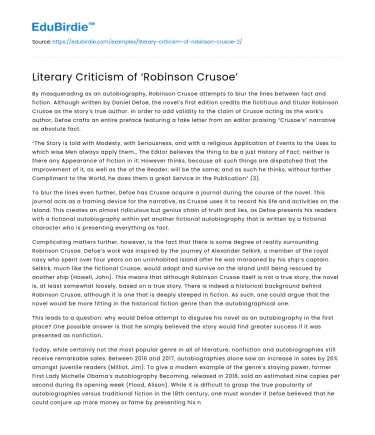By masquerading as an autobiography, Robinson Crusoe attempts to blur the lines between fact and fiction. Although written by Daniel Defoe, the novel’s first edition credits the fictitious and titular Robinson Crusoe as the story’s true author. In order to add validity to the claim of Crusoe acting as the work’s author, Defoe crafts an entire preface featuring a fake letter from an editor praising “Crusoe’s” narrative as absolute fact.
“The Story is told with Modesty, with Seriousness, and with a religious Application of Events to the Uses to which wise Men always apply them… The Editor believes the thing to be a just History of Fact; neither is there any Appearance of Fiction in it: However thinks, because all such things are dispatched that the Improvement of it, as well as the of the Reader, will be the same; and as such he thinks, without farther Compliment to the World, he does them a great Service in the Publication” (3).
Save your time!
We can take care of your essay
- Proper editing and formatting
- Free revision, title page, and bibliography
- Flexible prices and money-back guarantee
To blur the lines even further, Defoe has Crusoe acquire a journal during the course of the novel. This journal acts as a framing device for the narrative, as Crusoe uses it to record his life and activities on the island. This creates an almost ridiculous but genius chain of truth and lies, as Defoe presents his readers with a fictional autobiography within yet another fictional autobiography that is written by a fictional character who is presenting everything as fact.
Complicating matters further, however, is the fact that there is some degree of reality surrounding Robinson Crusoe. Defoe’s work was inspired by the journey of Alexander Selkirk, a member of the royal navy who spent over four years on an uninhabited island after he was marooned by his ship’s captain. Selkirk, much like the fictional Crusoe, would adapt and survive on the island until being rescued by another ship (Howell, John). This means that although Robinson Crusoe itself is not a true story, the novel is, at least somewhat loosely, based on a true story. There is indeed a historical background behind Robinson Crusoe, although it is one that is deeply steeped in fiction. As such, one could argue that the novel would be more fitting in the historical fiction genre than the autobiographical one.
This leads to a question: why would Defoe attempt to disguise his novel as an autobiography in the first place? One possible answer is that he simply believed the story would find greater success if it was presented as nonfiction.
Today, while certainly not the most popular genre in all of literature, nonfiction and autobiographies still receive remarkable sales. Between 2016 and 2017, autobiographies alone saw an increase in sales by 26% amongst juvenile readers (Milliot, Jim). To give a modern example of the genre’s staying power, former First Lady Michelle Obama’s autobiography Becoming, released in 2018, sold an estimated nine copies per second during its opening week (Flood, Alison). While it is difficult to grasp the true popularity of autobiographies versus traditional fiction in the 18th century, one must wonder if Defoe believed that he could conjure up more money or fame by presenting his novel as absolute fact.
Either way, no matter the rationale behind Defoe’s decision to sell his novel as a true story, it is undeniable that Robinson Crusoe blends fact with fiction to create a narrative, unlike any other true, or fictitious, story.






 Stuck on your essay?
Stuck on your essay?

